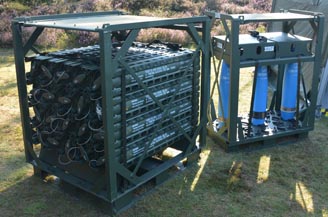NATO celebrates 25 years of munitions safety efforts
On 15 December 2016, NATO’s Munitions Safety Information Analysis Center (MSIAC) celebrated 25 years of improving participating nations’ efforts to develop, procure and use safer munitions with designed-in protection against accidents.

Accidents like this aboard USS Forrestal in 1967, led Alliance nations to create munitions which would be much safer in accident situations. Nations then sought to extend these efforts by sharing policies and technology through groups like MSIAC.
“The Center was founded in 1991 as a direct response to a number of deadly incidents where Allied bombs and missiles were exposed to operational accidents such as an airplane fuel fire,” said Dr Michael Sharp, MSIAC’s Project Manager. “The heat from the fire caused munitions to explode, which in turn killed nearby personnel, most of whom were working to control the fire,” he added.
During a brief ceremony in Brussels, Ernest J. Herold, NATO Deputy Assistant Secretary General for Defence Investment, said that sharing and expanding munitions safety technology within each participating nation of MSIAC, as well as making that technology available throughout the 13 participating nations are at the core of what NATO stands for and what MSIAC does.

Modern munitions have built-in features to help reduce unintentional reactions in accident scenarios. MSIAC works across its participating nations to share these technologies.
At the 2016 Warsaw Summit, Allies emphasised that they seek to contribute more to the efforts of the international community in strengthening security and projecting stability beyond NATO territory. A fundamental method of accomplishing this is through cooperation and partnerships, and MSIAC is a good example of how individual nations work together to achieve mutual goals.
A community of common interests in munitions safety
Patrick Lamy, Ammunition Safety Group Chair of NATO’s Conference of National Armaments Directors (CNAD), explained that “the collaborative and communal needs that established the project still drive its output today, and it succeeds by collecting the best and brightest work being done throughout the munitions community”.
At the ceremony, the presenters also pointed out how a project like MSIAC impacts the NATO community, participating in the process of policy and standards development, and facilitating shared knowledge across the Alliance. This in turn supports Alliance military operations through encouraging and coordinating common approaches among nations. This also extends to non-NATO nations such as Australia, Finland and Sweden.
“The first objective of safety and interoperability of our forces…is reached through the preparation of policies, standards, and guidelines to which nations are committed for all munition types and during all the phases of their life cycle,” said Mr Lamy. “MSIAC’s competence and expertise are vital to ensure these policies and standards are relevant, realistic, applicable and implemented,” he continued.
According to Mr Herold, collaboration is reflected in the creation and longevity of organisations like MSIAC and illustrates how voluntary collaborative efforts can be effectively deployed.
Dr Sharp closed by saying a fundamental tenet for the personnel at MSIAC is an understanding that Allied forces expect their munitions to be engineered to the highest levels of safety and reliability, and that this implicit trust cannot be violated.
Next year, from 3 to 5 April, MSIAC and the United Kingdom’s Defence Ordnance Safety Group (DOSG) will organise a workshop as part of the NATO Smart Defence Initiative on Integrated Munitions Health Management aimed at providing a definitive guide to improving munitions lifecycle management.
MSIAC is a NATO Project Office located in Brussels that is directly funded by 13 nations.1 It accomplishes its mission with a staff of seven scientists and engineers, and three technology and support personnel.
- MSIAC has 13 participating nations: 10 NATO member countries (Belgium, Canada, France, Germany, Italy, the Netherlands, Norway, Spain, the United Kingdom and the United States) and three NATO partner countries (Australia, Finland and Sweden).
